Introduction
Its been a long
while since the the SC1-4 webcam modifications
were made and lots has happened to bring down
the cost of entry level astro CCD cameras.
The SC5 modification board is a update of the
original webcam modification that allows the
modified camera to feel much more like a
dedicated astronomy camera. Also modified
webcams are often used to guide larger cameras
the SC5 modification board has an optically
isolated guide port to make connecting it to a
mount quite straight forward.
As part of this update the amplifier control has
been revisited (control is needed to eliminate a
glow in the corner of the CCD). As you can
read below the board provides independent
control of power supply to CCD and substrate
biasing. Tom How has a good page on
biasing webcam CCDs
http://astro.neutral.org/eq/ampoff.html
The SC5
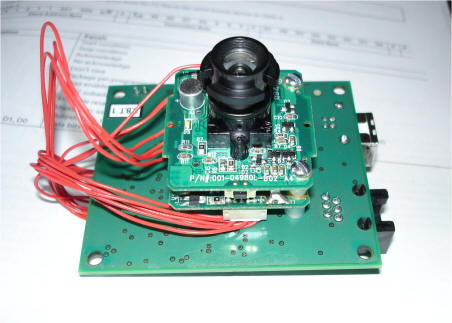
The board has holes that coincide with mounting
holes on the SPC900NC webcam. This makes
it possible to piggy back the board to
this camera and as the SPC900NC is particularly
easy to modify for long exposures (
Matthias Meijer ) it makes for a straight
forward conversion.
That said the SC5 board could be used with all
the webcams that use Sony ICX098 CCDs (ToUCam
Pros, Vestas, QC3000, most QC4000) see
http://homepage.ntlworld.com/molyned/web-cameras.htm
for more info on webcams and their CCDs.
The Board
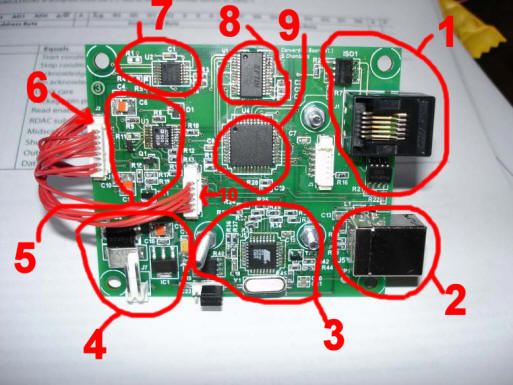
1 Optically isolated guide
port.
This is a
standard ST4 (LX200) compatible guide port
for connection to a telescope drive system in
order to issue drive corrections. As its
optically isolated the connection can be made
with a simple cable to many mounts. To use
the SC5 as a guide camera a connection from the
camera to a computer as well a suitable guiding
software is needed. 2
USB connection.
Rather then
needing a USB and parallel port connections, as
the original SC mods, this camera requires a
single USB back to the computer.
3 USB Hub section.
When connected
the SC5 presents the computer with a webcam and
a serial port . To control the
traffic between these sources a simple hub is
used. 4 External
power supply.
So far, all the
USB ports this camera has been used on can
provide enough power to run the webcam and the
chips on the board. However its
somewhat inevitable that there is a computer
somewhere what will not have enough power at its
USB ports. In this case the SC5 can
be powered from an external 12V source.
5 Amp and substrate control section.
The Sony CCDs
used in webcams have small amplifiers within the
CCD that are needed when reading an image out of
the CCD. However these also produce a
small amount of light by electro luminescence
that can appear as an annoying glow in the
corner of a image. Many circuits have been
proposed that help to over come this and all
work by lowering the voltage applied to the CCD
during exposure and restoring it for readout.
When the voltage drops from the 15V normal to
about 10V the glow is much reduced.
However there is a side effect. The
voltage supplied to the CCD is also used to
maintain the bias on the substrate. Put
simply, this is a voltage that allows the CCD to
collect the electrons produced when lights hits
it. By reducing the voltage to the CCD to
get rid of amp glow we also reduce the substrate
bias, which reduces the ability of the CCD to
collect electrons, which can result in the
camera being unable to produce high pixel
levels, especially when gain is not set at max.
The SC5 board can maintain the bias on the CCD
substrate independently of the voltage supplied
to the CCD. This allows the CCD supply to
drop to 6.7V (note the CCD always
needs some volts) to get rid of amp glow.
The board can be used to adjust the voltages of
both substrate and supply over a large range.
6 Connections to webcam circuit board.
These are the
'standard' mod connections for control of
exposure, shutter, amp etc. 7
Analogue switch.
This is the
equivalent chip that is used when doing a dead
bug mod directly into the camera but is a
particularly low resistance version.
8 USB to Serial port.
Provides a port
though which the PC talk talk to the SC5 board.
9 Microcontroller.
Controls the
circuit board! Also provides digital
multimeter functions to monitor amp and
substrate voltages. 10 USB
connection to webcam.
Software
| A simple
control panel is used to set up and
test the board as well as allowing
firmware updates if and when they
are needed. |
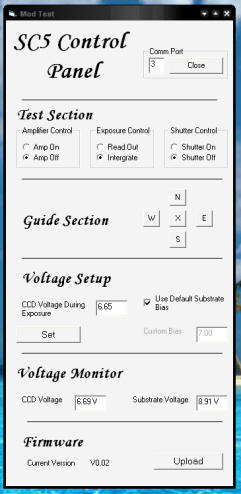 |
To capture
images, any of the software packages that
will control modified webcams though a
serial port can be used. example
K3CCDTools, Astrovideo, Astrosnap etc.
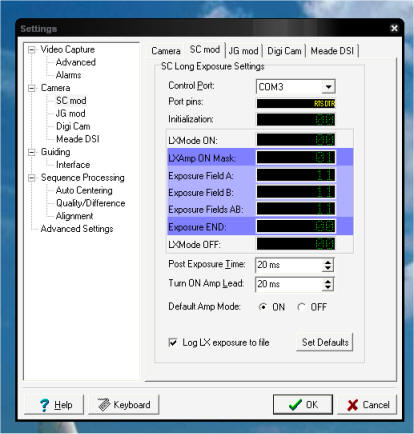 The
camera can be used with the default serial
settings in K3CCDTools The
camera can be used with the default serial
settings in K3CCDTools
Information of
guiding software coming soon!
Availability
Unpopulated
circuit boards might be made available, but
due to the amount of surface mount
components and the relatively inexpensive
automated population services we can use, it
would probably be best to provide complete
boards.
I am looking for
ways to provide these boards to interested
QCUIAG members without needing to order (and
pay for!) the large number of boards needed
for a manufacturing run. If
successful details will follow.
Cost is hard to judge as it will be related
to the number of boards made. Expect
less than the cost of the SPC900NC but maybe
not less than half the price of a SPC900NC.
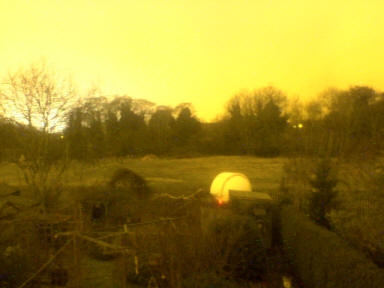
Picture of the
garden taken with the camera at one in the
morning on a rainy night in pretty much
pitch black conditions. Exposure 30
sec. Red light below dome from a small
led on a rain detector. Also glow on
the horizon from a park and ride / shopping
complex a couple of miles away. Thank
goodness they are not using hydrogen alpha
lights :)
|